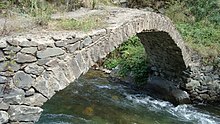
Tartar (river)
| Tartarchay Tartar, Թարթառ | |
|---|---|
 | |
 | |
| Native name | Tərtərçay (Azerbaijani) |
| Location | |
| Country | Azerbaijan Partly: Republic of Artsakh (de facto) |
| Region | Caucasus |
| Districts | Kalbajar, Barda, Tartar Partly: Martakert Province (de facto) |
| Cities | Kalbajar, Martakert, Tartar, Barda |
| Physical characteristics | |
| Source | Lesser Caucasus |
| • location | Near Istisu, Kalbajar District, Azerbaijan |
| • coordinates | 39°55′56″N 45°58′6″E / 39.93222°N 45.96833°E |
| • elevation | 3,120 m (10,240 ft)[2] |
| Mouth | Kura |
• location | Barda, Azerbaijan |
• coordinates | 40°26′49″N 47°18′26″E / 40.44694°N 47.30722°E |
| Length | 184 km (114 mi)[1] |
| Basin size | 2,650 km2 (1,020 sq mi)[1] |
| Discharge | |
| • location | directly downstream into Kura[2] |
| • average | 22 m3/s (780 cu ft/s)[2] |
| Basin features | |
| Progression | Kura→ Caspian Sea |
| Tributaries | |
| • left | Levçay, Ağdabançay |
| • right | Turağayçay |
The Tartar (Azerbaijani: Tərtərçay, Armenian: Թարթառ) is one of the tributaries of the Kura river located in Azerbaijan. It passes through the districts of Kalbajar, Barda and Tartar.

Overview

The Tartar is a left tributary of the Kura, the largest river in the Caucasus. The river originates in the area where Qonqur, Alaköz and Mıxtökən mountain ranges meet on the Karabakh Plateau in the vicinity of the hot springs village of Istisu located in Kalbajar Rayon of Azerbaijan.[3] The altitude where the river originates from mountain springs is 3,120 m (10,240 ft) above sea level. The river flows eastward through the whole Kalbajar Rayon (de facto Martakert Province) passing through Kalbajar city, Tartar and Barda raions and through Tartar and Barda cities before discharging into the Kura. The river has two left tributaries: the Levçay (36 km (22 mi)) and the Ağdabançay (19 km (12 mi)), and one right tributary, the Turağayçay (35 km (22 mi)). Sarsang reservoir was built on Tartar river in 1976 for electricity generation and irrigation purposes.[2]

Statistical information
The river is 184 km (114 mi) long, and has a drainage basin of 2,650 km2 (1,020 sq mi).[1] Tartarchay is considered one of the water-rich tributaries of Kura within Azerbaijani territory. The water volumes are sourced from rainfall (14%), snow (28%) and underground waters (58%). During spring and summer months, the snow melting in the mountains causes floods, making up 65–70% of the annual water flow. In August and September, the water levels decrease. From October until November, the rainfall increases the water levels again. The average annual discharge of the river is 22 m3/s (780 cu ft/s). Average annual flow is 693.8 million m3. The average mineralization of the river is 300–500 mg/L with hydrocarbons and calcium.[2]

Water uses
What was once the famous resort village of Istisu (lit. 'Hot Water' in Azerbaijani), which was occupied and ruined following the First Nagorno-Karabakh War, is located on the lower part of the river. The resort contains both natural drinking mineral water and hot water spring for bathing. Sarsang Hydro Power Plant with capacity of 50 megawatts is operated at the Sarsang reservoir of the river[4] and is the main source of electric energy for the Republic of Artsakh (40–60%).[5]

See also
References
- ^ a b c Тертер, Great Soviet Encyclopedia
- ^ a b c d e RIVERS OF AZERBAIJAN: Tərtərçay
- ^ Ministry of Ecology: Azərbaycanın çayları, gölləri və su anbarları Archived 2014-10-17 at the Wayback Machine Retrieved on 15 October
- ^ Artsakh HEK and ArmenBrok. "IPO Investment Memorandum" (PDF). Armenbrok CJSC. Archived from the original (PDF) on July 7, 2011. Retrieved January 12, 2011.
- ^ Mediamax (2009-03-03). ""Artsakh Hydroelectric Power Plant" realizes the first IPO in Armenia". Banks.am. Archived from the original on 2011-09-05. Retrieved 9 January 2011.
See what we do next...
OR
By submitting your email or phone number, you're giving mschf permission to send you email and/or recurring marketing texts. Data rates may apply. Text stop to cancel, help for help.
Success: You're subscribed now !
